Homemade Croissants
Homemade Croissants are totally worth the effort. Refrigerate the dough overnight to have freshly-baked, buttery croissants for breakfast.

Why are croissants so buttery and delicious? Because Croissants are made with a “laminated dough”. That is, a dough that’s wrapped around a big block of butter then rolled and folded to create lots and lots of flaky layers.
Puff Pastry, Danish Dough and Kougin -Amann are all made with laminated dough.
The key to a successful laminated dough is to create a strong gluten network to hold in all that butter. If the butter leaks out during baking, you loose the layers.
This dough has a little milk and sugar for flavor and tenderizing, but still develops plenty of butter trapping gluten. The results are fabulous.
Oh, by the way, if you’ve got an active sourdough starter, you can make Sourdough Croissants without any commercial yeast.
Ingredients
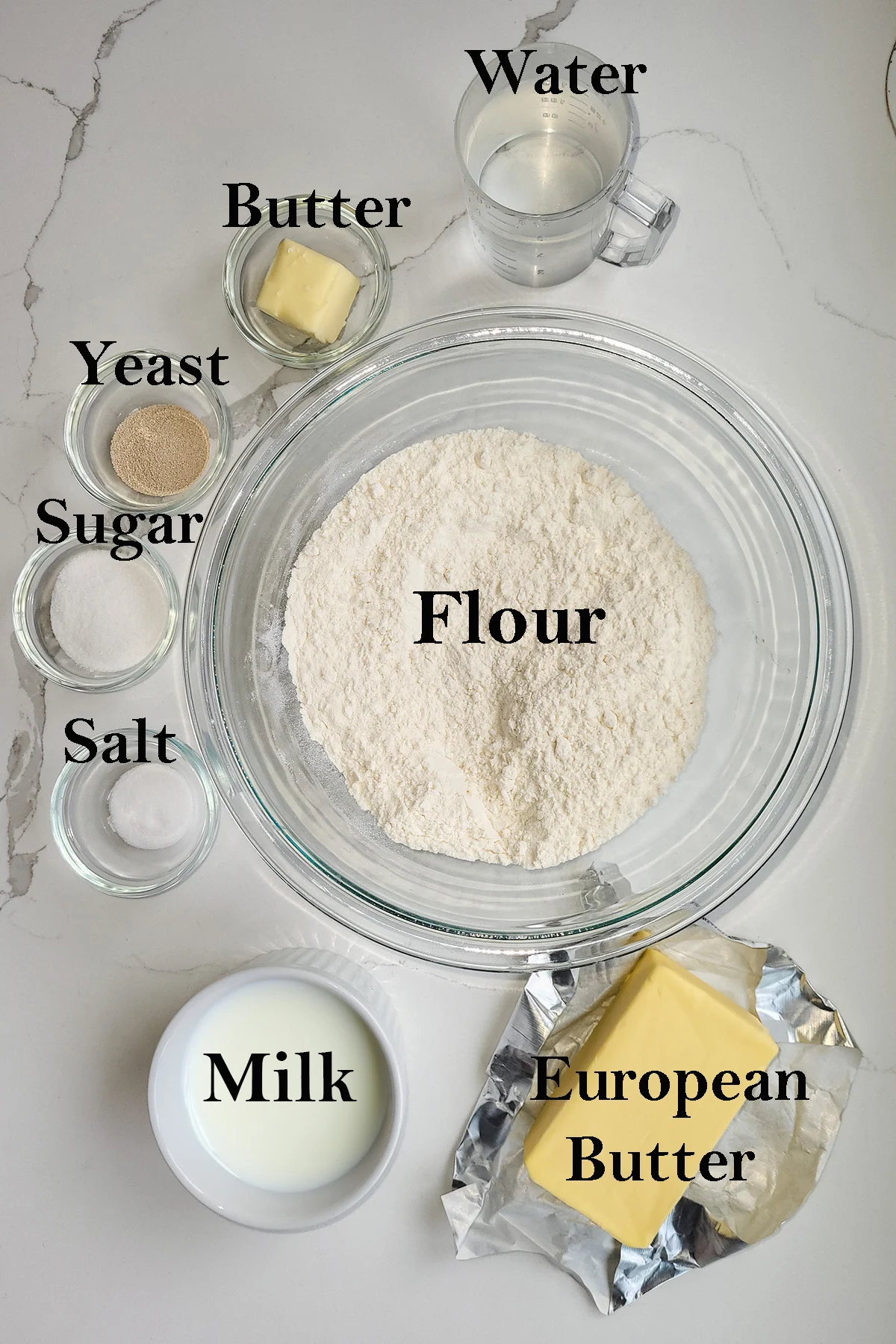
Ingredient Notes
- All purpose flour – Medium protein content ap flour makes a dough with enough gluten to keep the structure of the croissant, but makes a pastry that is tender and not chewy.
- European butter – I like to use European butter such as Kerry Gold for laminated dough because the low water content makes the butter more flexible. You can use American butter and still get good results.
- Dry Yeast – I don’t recommend rapid rise yeast for this recipe since the dough will spend quite a bit of time in the refrigerator.
How to make croissant dough:
See the recipe card for detailed measurements and instructions.
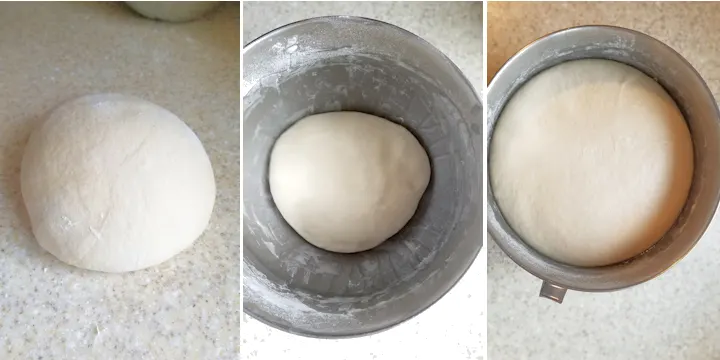
- Mix the dough set it aside until it is doubled in size.
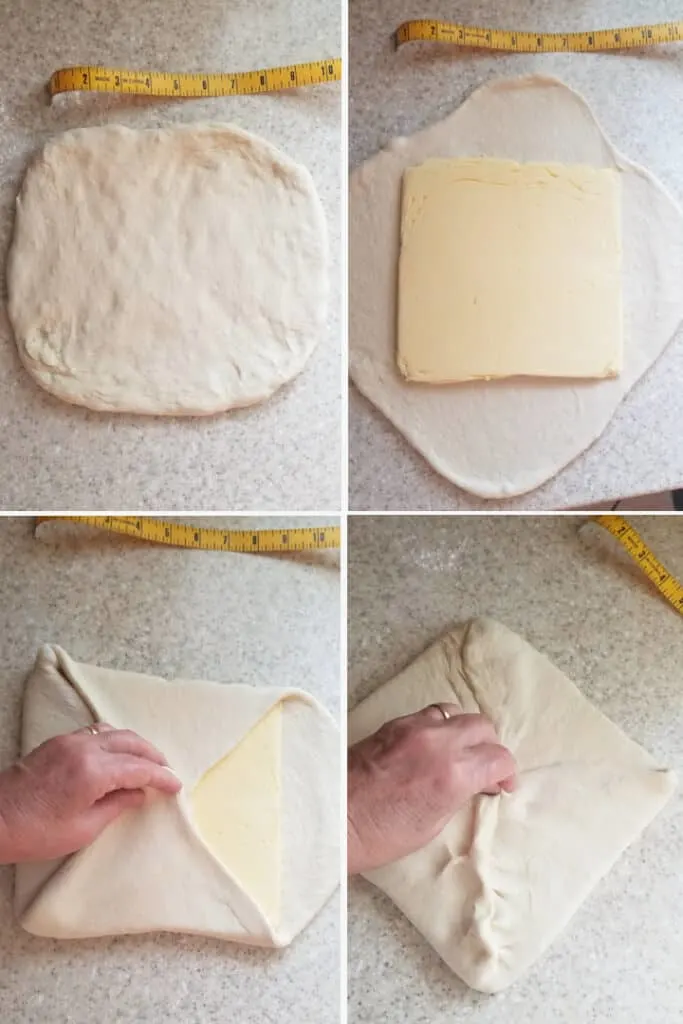
- Pat the dough to a square.
- Place the butter packet in the center.
- Fold the dough over the butter.
- Pinch the seams closed then begin rolling the dough.
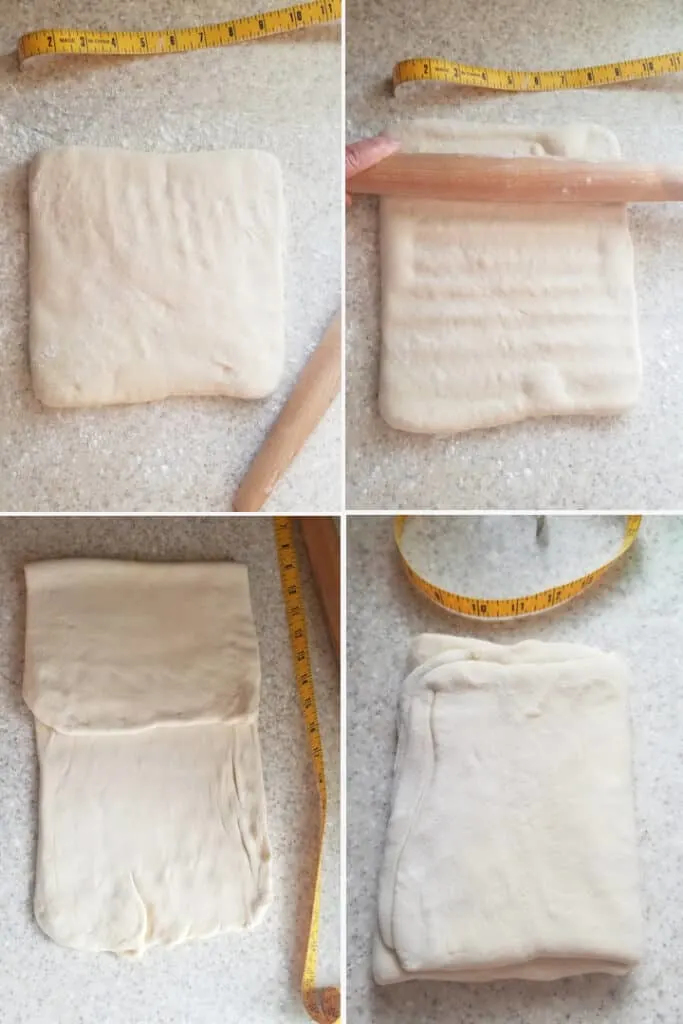
- Set the dough onto a lightly floured surface.
- Use the rolling pin to press on the dough before rolling to a 8″ x 24″ rectangle.
- Fold the dough like a letter. This is one “turn”.
- Repeat for a second “turn”. Chill the dough then do a third and final turn. Chill the dough for at least 2 hours before shaping the croissants.
How to Shape Croissants
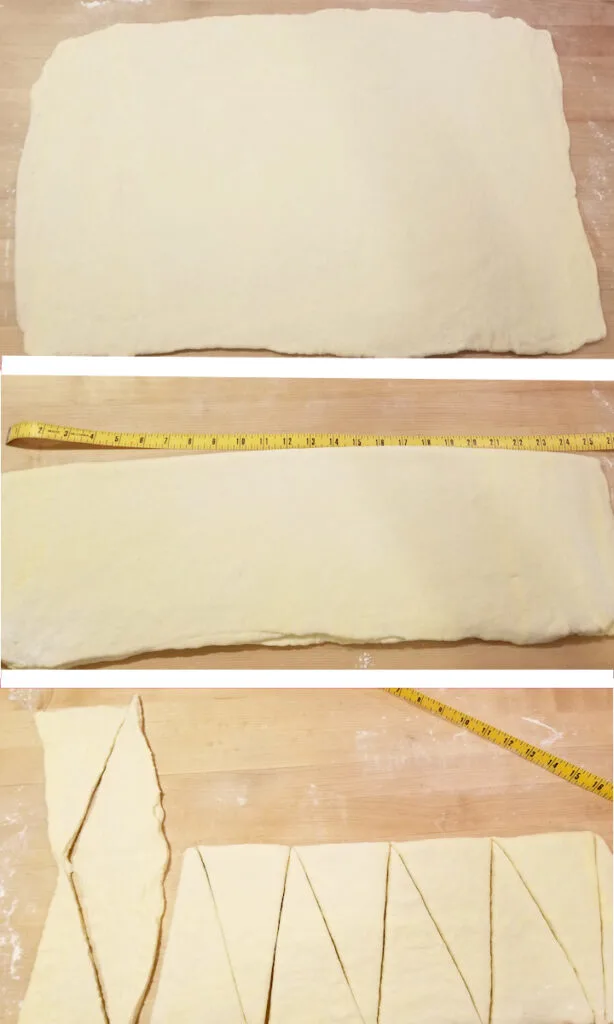
- Roll the laminated dough to a 16″x24″ rectangle.
- Fold the dough over to form an 8″x24″ rectangle.
- Starting from the left, measure along the top edge of the dough and make a mark at 2”. Using a pizza cutter or sharp knife, make a diagonal cut from that mark to the bottom left edge of the dough. Save the piece that you cut off.
- Working from left to right, measure and mark 4” increments along the bottom edge of the dough. Working from left to right, measure and mark 4” increments along the top edge of the dough. You should have a pattern of one top mark between two bottom marks. Starting from the top left, make a diagonal cut to the next mark on the bottom edge, forming a triangle. Then cut from the bottom to the next top mark. Continue this pattern to cut 11 alternating triangles and one 1/2 triangle end piece. Save the 1/2 triangle piece you cut from the end of the dough.
- Cut the triangles and unfold the dough to separate the croissants.
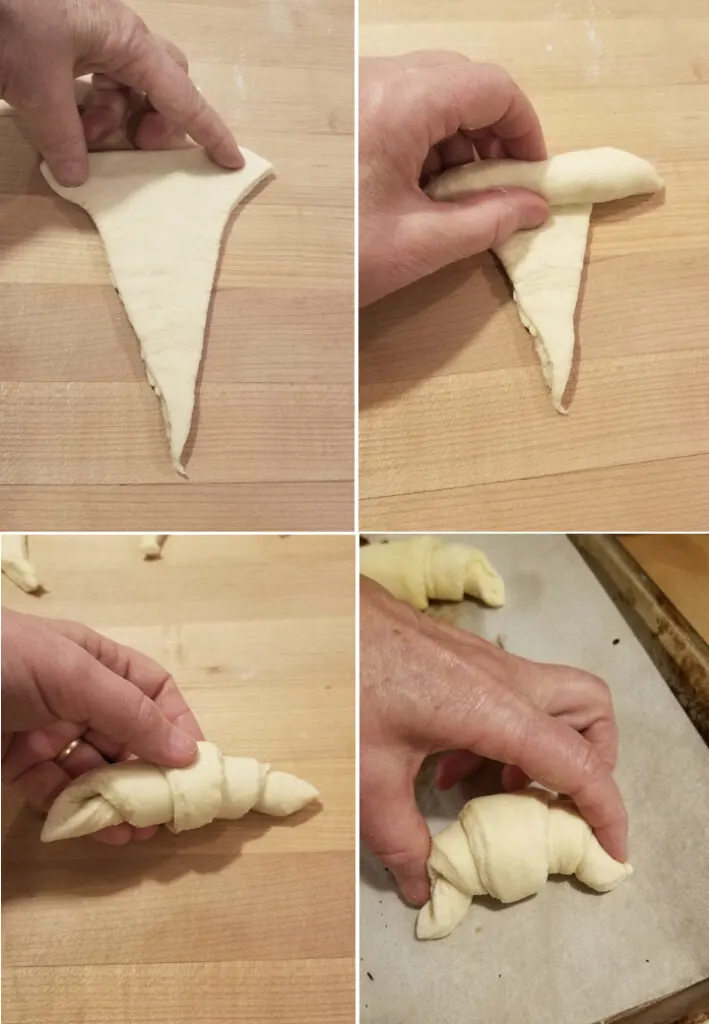
- Hold the triangle at the wide end and roll the dough while stretching from the point.
- Place the croissant on the tray and curve the two ends in to form a crescent shape.
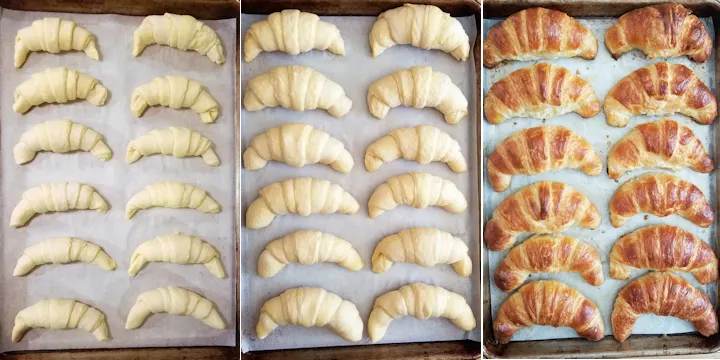
- Cover the croissants and refrigerate overnight.
- In the morning, allow the croissants to finish proofing while the oven preheats.
- Bake until well-puffed and golden brown.
A timeline for making Homemade Croissants:
- The dough can made be in the morning or early afternoon of day 1.
- While the dough is rising, prepare the butter packet and chill.
- Begin laminating the dough after the first rise.
- By early evening, the dough should be laminated, chilled and ready to roll.
- Roll and cut the croissants and set them onto two parchment lined baking trays. (At this point you can set some of the croissants on a tray in the freezer for longer term storage.)
- Cover the tray in plastic wrap and refrigerate overnight.
- The morning of day 2, take the tray out of the refrigerator.
- Preheat the oven while the croissants come to room temperature, then bake as directed.
- To make and bake in one day skip the overnight refrigeration. As soon as the croissants are assembled, cover the trays and leave them at room temperature to rise.
- The croissants are best the day they are baked. Leftovers (lol) can be frozen.
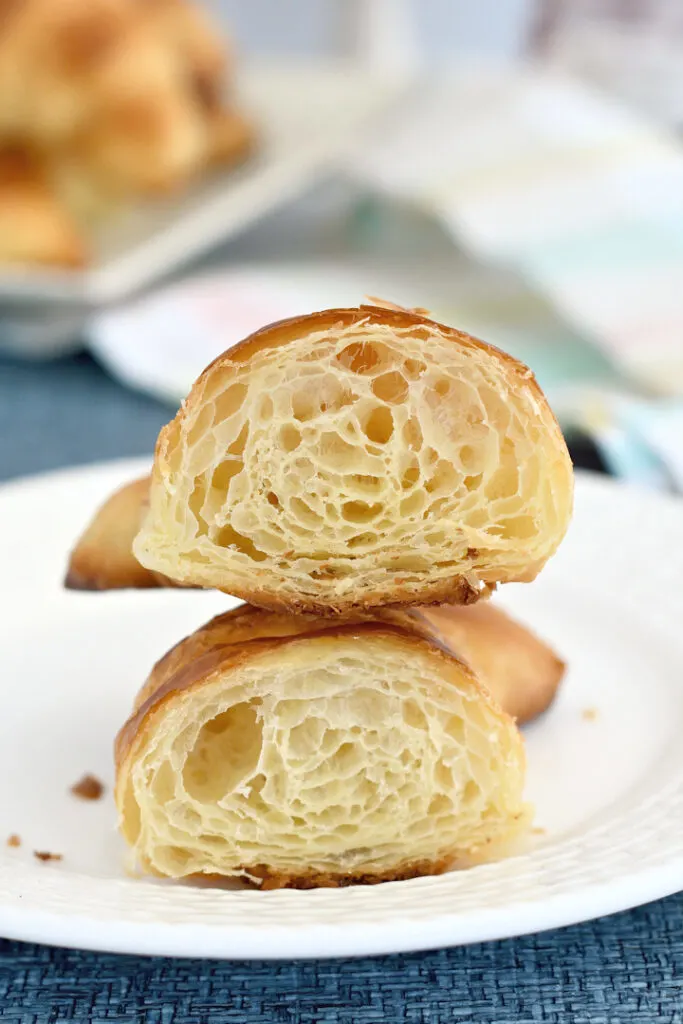

Now that you’ve mastered this dough, you’re ready to make Chocolate Croissants, aka, Pain au Chocolat and/or Almond Filled Croissants. I like to make one batch of dough and make half plain and half chocolate and/or almond croissants.
If you love this recipe as much as I do, I’d really appreciate a star rating and a quick comment. Ratings and comments help my recipes show in search results. Thanks!
Croissant Recipe
Ingredients
- 6 oz warm water (¾ cup)
- 8 oz whole milk (1 cup, scalded and cooled to 110 °F)
- 2 ¼ teaspoons dry yeast (1 packet)
- 20 oz unbleached all purpose flour (4 cups, see note)
- 3 oz granulated sugar (⅓ cup)
- 2 teaspoons table salt
- 16 oz unsalted butter (pliable but still cool (see note))
- 1 egg ( for egg wash)
Instructions
- Combine6 oz warm water, 8 oz whole milk, 2 ¼ teaspoons dry yeast and 2 cups (10 oz) of the flour in the bowl of a stand mixer with the paddle attachment. Mix to form a thick batter. If working by hand mix with a wooden spoon. Cover the bowl and let it rest for 30-60 minutes.
- Switch to the dough hook. Add 3 oz granulated sugar, 2 teaspoons table salt and remaining flour. Mix until the dough gathers on the hook and clears the sides of the bowl. If working by hand stir in as much flour as you can with a wooden spoon, then finish kneading in the rest of the flour by hand. Knead the dough for 5 minutes until silky and supple.
- Transfer the dough to a lightly oiled bowl, turning once to coat the dough. Cover the bowl and set it aside at room temperature for 1- 1 1/2 hours, or until doubled in size.
- While the dough is rising, prepare the butter package. Draw an 8" square in the center of a piece of parchment paper. Flip the paper over and 16 oz unsalted butter in the middle of the square. Fold the parchment over the butter. Use a rolling pin or other heavy object (I use the flat side of a meat tenderizer) to flatten the butter to fill the 8"x 8" square. You can lift the paper if it sticks. Trim and rearrange the edges of the butter as needed. Fold the butter into the parchment and place in the refrigerator. 30 minutes before the dough is ready, remove the butter from the refrigerator. (If your kitchen is very warm, take the butter out 10 minutes ahead.) The butter should be firm and cool but a little flexible for layering into the dough.
- Turn the dough out onto a lightly floured surface. Do not knead out the air. Roll the dough to a 10" square. Once you have a square, roll from each of the four sides to form a 3" flap of the dough, leaving the center thicker than the flaps. You should end up with a square with four "flaps" coming out from the corners. Now it’s time to layer in the butter.
- Unwrap the butter and place it in the middle of the square. Fold the flaps so they overlap and enclose the butter, pinching in the corners as necessary to glue the seams together. You should now have an 8" square of dough with the butter enclosed. Use the rolling pin to gently press on the square to flatten it. Roll the dough to a 8" x 24" rectangle. Take your time to roll gently and evenly so the butter stays in one layer in the dough.
- Orient the dough so the long side of the rectangle is facing you. Brush off the excess flour. Brush the entire surface of the dough with cold water. Fold the right 1/3 of the dough towards the middle then fold the left 1/3 of dough over enclosing it like a letter. This is the first "turn".
- Orient the dough so the closed edge is on the top side and the open edge is facing you. Roll the dough again to an 8" x 24" rectangle. Brush off the excess flour. Brush the entire surface of the dough with cold water and again fold the dough like a letter. This is the second "turn". Set the dough on a sheet pan, cover with plastic and refrigerate at least 30 minutes.
- Remove the dough from the refrigerator and do a third turn exactly like the first 2. Wrap the dough and place it in the refrigerator for at least 2 hours.
- Line 2 baking sheets with parchment paper or a silicone baking mat. Roll the chilled dough to a 24” long x 16” wide rectangle. With the long side facing you, fold the top half of the dough over the bottom half to form a 24” long x 8” wide rectangle.
- Starting from the left, measure along the top edge of the dough and make a mark at 2”. Using a pizza cutter or sharp knife, make a diagonal cut from that mark to the bottom left edge of the dough. Save the piece that you cut off.
- Working from left to right, measure and mark 4” increments along the bottom edge of the dough. Working from left to right, measure and mark 4” increments along the top edge of the dough. You should have a pattern of one top mark between two bottom marks. Starting from the top left, make a diagonal cut to the next mark on the bottom edge, forming a triangle. Then cut from the bottom to the next top mark. Continue this pattern to cut 11 alternating triangles and one 1/2 triangle end piece. Save the 1/2 triangle piece you cut from the end of the dough.
- Unfold the triangles and cut each in half along the joint so you have a total 22 triangles. Unfold the 1/2 triangle pieces which you cut from either end. Pinch them together to form 2 more triangles.
- To form a croissant, hold a triangle from the wide base in one hand and gently stretch the width a little. Set the dough on the work surface with the narrow end pointing towards you. Roll the croissant towards the pointed end, holding on to the tip and gently tugging as you roll. Bend either end of the croissant towards the middle to form the crescent shape.
- Set the croissants on the prepared baking sheets, 3” apart. You should fit a dozen croissants per half sheet pan. Cover with plastic wrap and set in the refrigerator overnight. (see note)
- In the morning. Take the croissants out of the refrigerator. Allow them to proof at room temperature for 1-2 hours. The exact time needed for proofing will vary depending the temperature of your kitchen. They should be at least 50% larger than they started and feel airy and puffy. Preheat the oven to 400 °F. Brush the croissants with egg wash. Bake the croissants until golden brown, 15-20 minutes. Serve warm or room temperature.
Would you like to save this recipe?
As an Amazon Associate and member of other affiliate programs, I earn from qualifying purchases.









This was amazing!
My first time to make croissants and I really thought it was not going well, but in the end they were perfect!
I did try freezing and thawing/baking…. A lot of butter baked out onto the pan. It was still tasty but a little tough. Any tips on making this better?
Thanks!